3.08 till 5.08.2016, 2 days, currency exchange rate 1 € = 1.5 AUD (Australian Dollar)
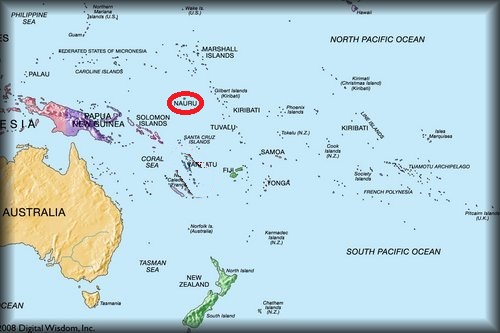
Introduction
It is a country with a quite original nearby past. Few people have heard about this smallest republic, and the third the smallest independent country in the world (21 km2, after Vatican and Monaco). Even less people realize that some years ago it was the richest country in the world when it comes to income per capita. This was due to two simple reasons - the country exported high-quality phosphates, and at the same time there were only ten thousand Nauru citizens officially living on the island. Unfortunately, statistics with averaged data often do not reflect the real situation, because the majority of residents don't have much from it, and only a few benefits from mining.
If at any time in history a small country was rich in natural resources, it did not happen without the interference of foreign states. And in this case, the Micronesians were not asked for an opinion. The country passed through the hands of Germans, Australians, New Zealanders, British and Japanese's. They gained independence late in 1968, just before the raw materials began to run out. All the above countries exported as many sedimentary rocks as they were able to dig. Although there are several theories of these rocks origins, it does not change the fact that phosphate rock is used as a fertilizer, and one of its chemical components are organic parts of animals, such as faeces. Simplifying the matter, Nauru is rather the only country in the world that depends, however you look at that, from the "shit".
If we are looking for a paradise island with palm trees and beautiful beaches, let avoid Nauru.
![]()
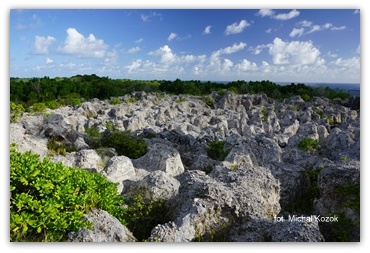
We started visiting the island from its interior. Straight from the hotel we walked along a gravel path towards the centre, without a more precise plan. We just wanted to see these famous phosphors. And I must admit that despite the ubiquitous grey powder and dust, the forest of rock trees looks original, I have not seen anything like it before. We did not have to walk for a long time, because almost every passing car picked us up. We saw open mines that extract and then crumble and grind the phosphates, as well as the views from numerous hills. This is not a panorama that is expected in the Pacific Islands, but not to see it in Nauru, it would also be a sin.
After another few walks and hitchhikes, we tried to get the highest summit of the country. Our hitchhikers took us to the radio antennas, but the area was fenced, and we had to retreat. 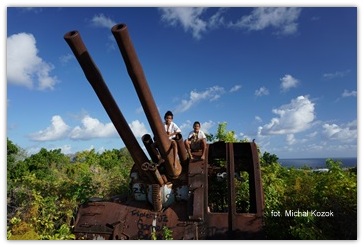
Inside the island there is another interesting object, but I missed it in purpose. This is an Australian Detention Centre. This is a delicate matter, because when Nauru began to run out of the resources, its only natural wealth and was on the verge of bankruptcy, Australia offered them financial help in exchange for the possibility of establishing the centre there. Unfortunately, the conditions in which refugees live are far from the standards set by Human Rights, and this is an awkward political game.
On the second day I decided to circumnavigate the whole country. This is a rare opportunity, because usually geographical, official or political borders limit us from such achievements. 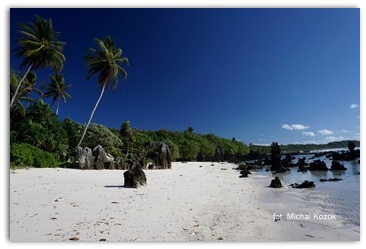
From Menen Hotel we went to the north and almost immediately we found an interesting rock formation, called Pinnacles, standing by the beach in Anibare. Because it was a low tide, we could have a little stroll around. The entire beach was just for us - the rocky bottom and stony beaches generally do not attract locals, and there is lack of tourists here.
Another attraction of the island is Hole in the Wall. Although the attraction is here an exaggeration word. But what to do in Nauru, you must see every otherness, otherwise we could be bored. Anyway, the search for anything forces us to have more contact with people, and these are rather only positive. In any case, some 200 meters before the village of Anabar, on the right side there is a fenced farm of some vegetables, with a blue building and a plaque confirming that Taiwan funded this gift. However, on the left side, or towards the interior of the island, there is a narrow forest path between trees, 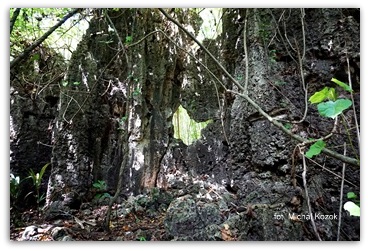
At the northern end of the island is the Capelle and Partner supermarket, a self-service shop. Next to it is a fish bar, and on the beach side are roofed sheds - the perfect place for a meal and rest. A lot of employees from nearby companies relax here during the lunch time, so there is another opportunity to make friends.
Nauru is only 40 km south of the equator, so it will not be a problem to march south - the sun does not shine in the eyes. A head cover will be useful. Now we were heading towards the harbour, and at the same time the most inhabited part of the island. Here, I had to decide very carefully how not to leave the shore too far. A part of the harbour was fenced, but most of the time I walked between container ships, forklifts, and trucks. My furthest point from the shore did not exceed 150 meters. It was, however, the poorest part of the island - the buildings 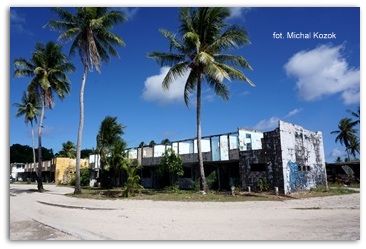
It was still left to complete the circumnavigation, and this was associated with the passage through the capital of the country, Yaren. I am a little joking here, because Yaren is a couple of buildings, including a president's and a government's house, so it's technically the capital. I have not met the president, nor the guards. Yaren is located near the airplane's runway, which did not fit on the island and the tip had to be extended on the coral reef.
![]()
accommodation – I must admit that I slept the first and probably the last time in the best hotel in the country. Menen Hotel is expensive but acceptable - AUD 155 (€ 103) per room per night. When it comes to quality - well, time of splendor is already behind - it is slowly falling apart, there are no bars in the balcony balustrade, plaster is falling off, the remains of water are rotting in the swimming pool. However, the tap water was running, the fridge and light worked, so it was not too bad. There is a bar and restaurant at the hotel.
Reservation of accommodation is quite difficult - details at the end of the article about the visa.
transport – Nauru Airlines is also an original matter. Not even by the fact that they have only a few Boeing, but because it is the only known airline that serves international destinations and does not have domestic flights (it is not difficult due to the size of the country), although it handles domestic flights of another country (between the islands of the State of Micronesia). It is also the only operating airline in the country.
There are no taxis in the country, but if we ask in a hotel, there will be someone who will take us around the island. There are also factory and school buses riding on the island, for which there is a chance to get a ride, but for us the most common form of movement outside of our own feet was hitchhiking. The average waiting time was under five minutes.
food – I brought 6 litres of water from Australia, because I heard that it is terribly expensive. But it was not that bad - a bottle of water costs AUD 2, a meal in the restaurant from AUD 6, beer AUD 4. The owners of small restaurants are often Chinese.
flight – the only carrier is Nauru Airlines. Direct one-way flight to Nauru is from Brisbane (Australia) from AUD 600 (€ 380), Nadi (Fiji) from AUD 410 (€ 260), Honiara (Solomon Islands) from AUD 230 (€ 145) and from Tarawa (Kiribati) from AUD 185 (€115). Airline still serve flights to the Marshall Islands (Majuro) and Micronesia (via Tarawa). It is not cheap so.
My international ticket was as follows:
Brisbane – Nauru – Majuro – Tarawa – Brisbane. A total of AUD 1678 per person (€ 1060).
weather – monsoon season occurs between November and February, and average temperatures throughout the year are between 25 and 30 degrees C.
currency – Australian dollars
visa – Nauru is reluctant to issue tourist visas, rumours say that only about 60 are issued annually. There were also cases that Australian parliamentarians were not allowed in. Citizens of some Pacific Islands and Russia and Israel do not need to apply.
Officially obtaining a visa should not bring many problems - just complete the application, attach a photo, and book the hotel.

The Menen Hotel website always claims that there are no vacancies, even in two-year time. The staff does not reply to emails. So, I contacted Nauru Airlines in Brisbane, where Fabiana, native Nauru, helped me. Unfortunately, after a few phone calls, she stated that the Menen Hotel does not have places in the period required by me, nor a month earlier or later, and there is still a couple from Italy waiting for her to book place for them. Due to weird situation that Fabiana's mother was Polish, I got a special service and hotel was soon booked.
I had a reservation at the Hotel Menen. I submitted an electronic application to Kiribati consulate in Brisbane nauru.consulate@brisbane.gov.nr, and a few days later I received an electronic permit to enter the country with tourist visa (although European residents should apply to other Kiribati consulates, usually those nearest to their place of residence). During the immigration control on the spot, no visa fee was charged - it should be AUD 50 (€ 31). I did not argue this time :)